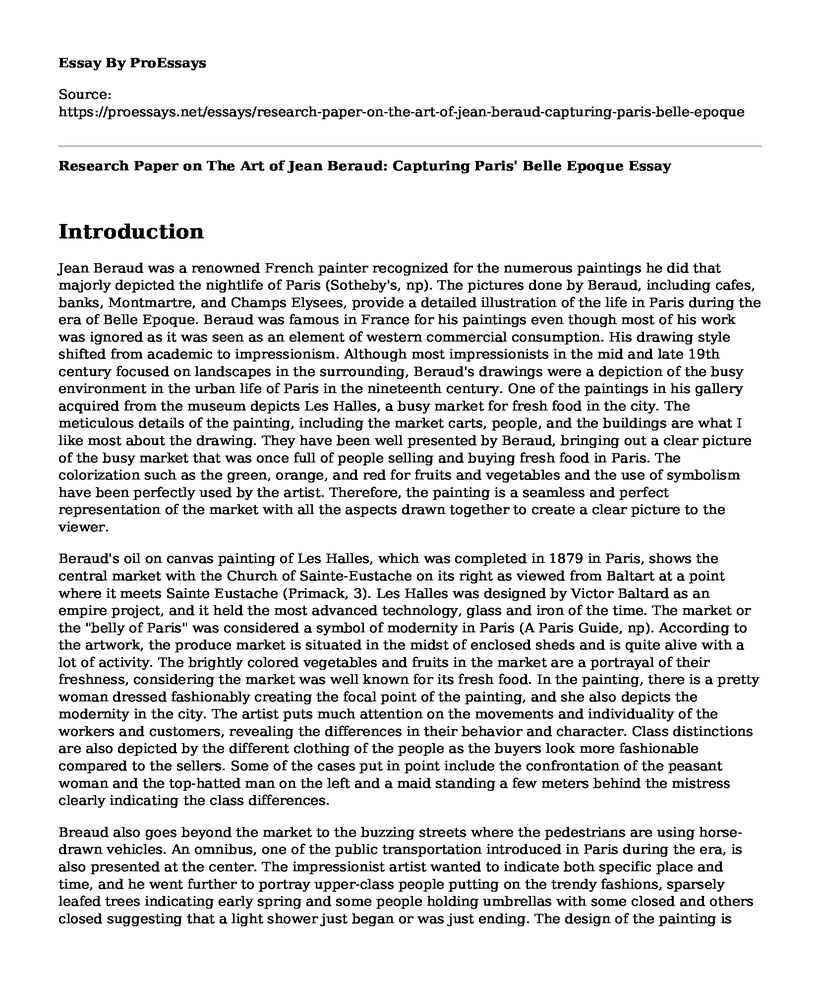Introduction
Jean Beraud was a renowned French painter recognized for the numerous paintings he did that majorly depicted the nightlife of Paris (Sotheby's, np). The pictures done by Beraud, including cafes, banks, Montmartre, and Champs Elysees, provide a detailed illustration of the life in Paris during the era of Belle Epoque. Beraud was famous in France for his paintings even though most of his work was ignored as it was seen as an element of western commercial consumption. His drawing style shifted from academic to impressionism. Although most impressionists in the mid and late 19th century focused on landscapes in the surrounding, Beraud's drawings were a depiction of the busy environment in the urban life of Paris in the nineteenth century. One of the paintings in his gallery acquired from the museum depicts Les Halles, a busy market for fresh food in the city. The meticulous details of the painting, including the market carts, people, and the buildings are what I like most about the drawing. They have been well presented by Beraud, bringing out a clear picture of the busy market that was once full of people selling and buying fresh food in Paris. The colorization such as the green, orange, and red for fruits and vegetables and the use of symbolism have been perfectly used by the artist. Therefore, the painting is a seamless and perfect representation of the market with all the aspects drawn together to create a clear picture to the viewer.
Beraud's oil on canvas painting of Les Halles, which was completed in 1879 in Paris, shows the central market with the Church of Sainte-Eustache on its right as viewed from Baltart at a point where it meets Sainte Eustache (Primack, 3). Les Halles was designed by Victor Baltard as an empire project, and it held the most advanced technology, glass and iron of the time. The market or the "belly of Paris" was considered a symbol of modernity in Paris (A Paris Guide, np). According to the artwork, the produce market is situated in the midst of enclosed sheds and is quite alive with a lot of activity. The brightly colored vegetables and fruits in the market are a portrayal of their freshness, considering the market was well known for its fresh food. In the painting, there is a pretty woman dressed fashionably creating the focal point of the painting, and she also depicts the modernity in the city. The artist puts much attention on the movements and individuality of the workers and customers, revealing the differences in their behavior and character. Class distinctions are also depicted by the different clothing of the people as the buyers look more fashionable compared to the sellers. Some of the cases put in point include the confrontation of the peasant woman and the top-hatted man on the left and a maid standing a few meters behind the mistress clearly indicating the class differences.
Breaud also goes beyond the market to the buzzing streets where the pedestrians are using horse-drawn vehicles. An omnibus, one of the public transportation introduced in Paris during the era, is also presented at the center. The impressionist artist wanted to indicate both specific place and time, and he went further to portray upper-class people putting on the trendy fashions, sparsely leafed trees indicating early spring and some people holding umbrellas with some closed and others closed suggesting that a light shower just began or was just ending. The design of the painting is also quite impressive with a radical visual balance of the main elements of the picture. The colors in the middle of the painting are brilliant and bright, drawing the movement of the eyes towards the center, which is full of activity.
Beraud was an artist who was ignored by most Russian artists, but his work was quite adorable, and that is what makes his history to date. The impressionist artist brought out the real-life in Paris after the revolution, and even though the market was destroyed, his art still holds meaning. His paintings are quite on point and do not need one to have a professional analyst to understand their true meaning. Therefore, although he is dead, his art still lives it a full representation of who he was when alive.
Works Cited
A Paris Guide. Les Halles. A Paris Guide. Available at < http://www.aparisguide.com/leshalles/ > accessed on 27th June 2019.
Primack, Mark. Les Halles: Cultivating Authenticity in the Belly of Paris. Research Gate. Available at < https://www.researchgate.net/publication/324217008_Les_Halles_Cultivating_Authenticity_in_the_Belly_of_Paris > accessed on 27th June 2019.
Sotheby's. Jean Beraud: Works by Jean Beraud at Sotheby's. Sotheby's. Available at < https://www.sothebys.com/en/artists/jean-beraud > accessed on 27th June 2019.
Cite this page
Research Paper on The Art of Jean Beraud: Capturing Paris' Belle Epoque. (2023, Jan 29). Retrieved from https://proessays.net/essays/research-paper-on-the-art-of-jean-beraud-capturing-paris-belle-epoque
If you are the original author of this essay and no longer wish to have it published on the ProEssays website, please click below to request its removal:
- The Spanish Painting in the Cultural Expression Essay
- Nixon and Obama Contribution to Humanities Paper Example
- Media Exposure and Violent Crimes - Essay Sample
- Essay on Superhero Movies: Societal Impact & Perceptions in Today's Culture
- Paper Example on Exploring Representation of LGBTQ Community in Arab Cinema
- Henry Box Brown's Escape From Slavery: A Remarkable Journey - Essay Sample
- Essay Example on Monster (2003): The Tragic Life of Serial Killer Aileen Wuornos







